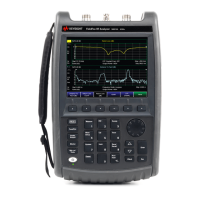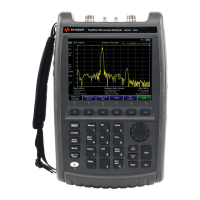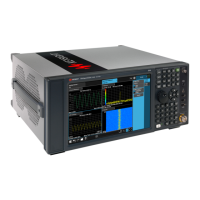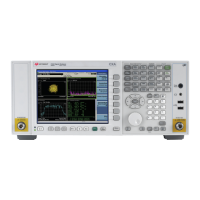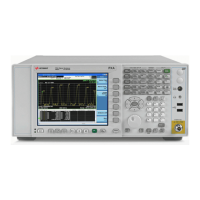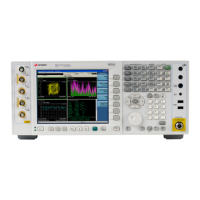Keysight N9927-90001 User’s Guide 209
RTSA (Real-Time Spectrum Analyzer) Mode—Option 350 (CPU2 Only)
RTSA Mode Settings
Manually set Scale, acquisition, and Reference Position.
— Scale Manually adjust the dB scale per division to view specific areas of the
current trace. Enter a value using the numeric keypad, the arrows, or
the rotary knob. Then press Enter
.
— Ref Level
Manually set the value of the reference line. Enter a negative
value by pressing Run/Hold (+/-)
either before or after typing a value. This
can also change the RF Attenuation setting. See “Attenuation Control” on
page 209.
— Ref Pos
Manually set the position of the reference line. Values must be
between 0 (top line) and 10 (bottom line). Default position is zero (top).
External Gain
When using an external amplifier or attenuator, the RTSA mode trace
amplitude values can be offset to compensate for the effect of the external
device. This effectively moves the reference plane of the RTSA measurement
port out to just beyond the external device. For example, when using an
external preamp with gain of +10 dB, enter this value for External Gain, and the
data trace across the displayed frequency span will be adjusted down by 10
dB.
When RF Atten is set to Auto, you may see a change in the RF Attenuation
value. This is an attempt to measure the signal at top of screen (the
acquisition) without overloading the RTSA first mixer.
How to Set External Gain
—Press Scale/Amptd.
—Then External Gain
— Enter a value using the numeric keypad, the arrows, or the rotary knob
(positive for gain; negative for loss). Values in increments less than 5 dB
must be typed using the numeric keypad. Then press Enter
ExtGain xx dB is shown at the top of the screen.
Attenuation Control
Both the RF Attenuation and Preamp functions control the power level into the
RTSA.
When too much power is present at the RF Input port, ADC Over Range
appears on the FieldFox screen. This does not necessarily mean that damage
has occurred, but that the measurement is probably compressed.

